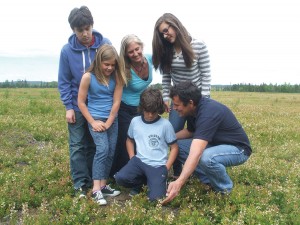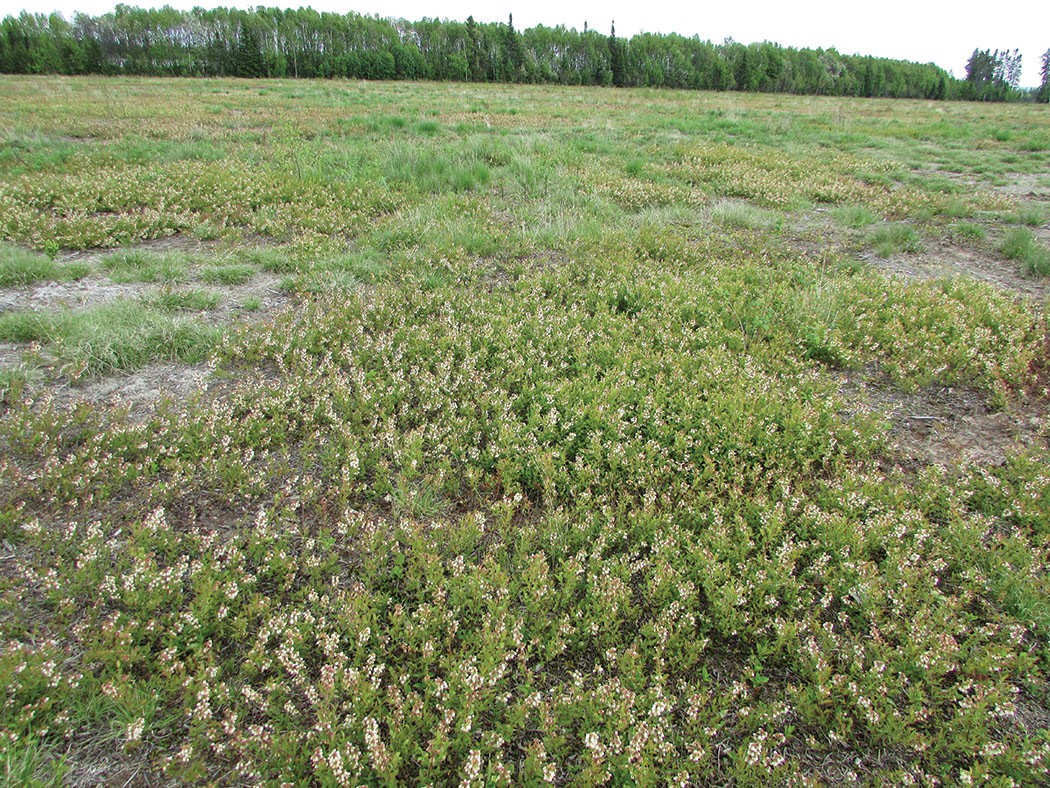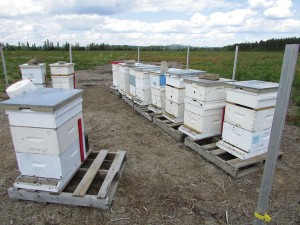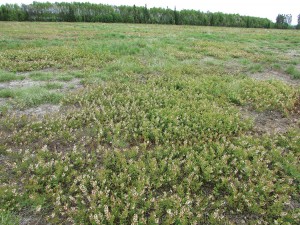by Alan Harman
Canadian Trevor Laing is importing thousands of workers to try to reduce Northern Ontario’s biggest export – its youth.
He is operating a recently created 375-acre wild blueberry farm outside Wawa, a small community on the northern edge of Lake Superior and 575 miles northwest of Toronto.
And now his Algoma Highlands Wild Blueberry Farm and Winery is beginning to expand after just four years, thanks to a lot of help from the thousands of honey bees from Thunder Bay, 300 miles to the west.
“We researched pollinators before we started,” Laing says.
“We looked at native pollinators and at the beginning, I figured there are 20-plus native species out there.”
With those pollinators in mind, Laing set a 655-foot maximum for the size of his fields and developed buffer zones on the edges to encourage the native pollinators that live along the fringes to migrate in to the blueberry fields for the pollen.
“With less coverage needed in the fields, we felt they were fine,” he says. “But as the fields became more and more developed, as the plants spread in, we definitely needed to bring in bees.”
He talked to people with the Ontario Beekeepers’ Association and other experts about pollination. They all said he needed more pollinators.
“We were thinking about bringing in our own bees, but because of the amount of work and the time involved, we decided to use an outside source,” Laing says.
That’s where Barry Tabor of the Bears, Bees and Honey Apiary in Shuniah, outside Thunder Bay, comes in.
Laing set up a pollination deal with him ahead of other apiaries.“I had no shortage of offers from beekeepers,” Laing says. “The phone range constantly.
“The people from Ontario move their bees out to the East Coast for the blueberries and it’s a long way. We are much closer and we get a discount for that. I know what they pay out there, so we pay a little less.”
The farm has a permanent staff of five as well as 25 seasonal jobs, something Laing says is important.
“The biggest export in northern Ontario is our children – we lose them,” he says.
He figures as his business grows, so will the job creation in a region where unemployment is so endemic most young people are forced to move south in search of work.
Laing sees the farm as a legacy to give his children McKenzie, 15, Talus 13, Aiden 11 and Quinn 9, the opportunity to stay in the remote region.
“If they want to come and work on the farm great – but it is whatever they want to do,” he says.
A farm gate store was planned for this Summer to grab the tourist blueberry business, and there were sales booths at the region’s Summer fairs and at the Sault Ste. Marie, ON, farmers’ market.
Laing’s first production was in 2011, and he didn’t use commercial pollinators until 2013.
“We brought in 10 hives to start, and we noticed a huge production increase in the fields where the hives were,” he says.
This year, 40 hives were on the blueberries for three weeks.
“We have each year increased the number of hives.”
He is hoping to reach 200 hives within the next five years.
“We are going to try and do it with organic growth, through the beekeeper we have now.
“I know we are going to do north of 100,000 lbs. for the season, and I would like to see how close we come to 200,000 lbs.,” he says.
The soil has poor fertility and the basic treatment is with nitrogen and nitrates. For every ton of fruit grown, Laing has to put 30 lbs. of nitrogen back.
His aim is to harvest 4,000 lbs. an acre or 600,000 lbs. annually
“My soil guy, Todd Mason, doesn’t think it is out of the question,” Laing says. “We know we need the bees to do that.”
Tabor, who runs 60 hives in a family operation, says the blueberry honey yields are not high.
This year with the cool Summer, he was expecting just 10 lbs. of honey a hive, compared with the best years when it might reach 35 lbs.
The honey coming off the blueberry fields is a medium type, a fairly dark, amber color.
“The smell is different,” Laing says. “You can’t smell the blueberry, but it is similar to a wild flower honey. It is very good.”
Laing is beginning the legal process of becoming a licenced apiary area and aims to open a small winery in the processing plant next year.
“Under Ontario law, to produce mead or honey wine, you have to have a minimum of 100 hives and this would complement our blueberry wine,” he says. “One hundred is a nice goal to get to – so we get the licence for the winery.”
To reach those numbers, Tabor says Laing will need to bring in at least one more beekeeper.
Handling that number would be too much work for his small family operation.
Laing is approaching the stage of deciding on a honey source for the winery, but says he will probably just purchase it from beekeepers.
Under Ontario law, he can sell his honey wine production either on site or through the provincial government’s liquor monopoly, but not both.
The on-site wine store was a no-brainer.
“If we sold it to the LCBO (Liquor Control Board of Ontario), they take 53% of the price and the producer has to pay the taxes on top of that,” Laing says. “You are allowed one winery attached to a fruit operation and can sell it there.”
He has hired a recent university graduate, Mandi Ramhandie, to manage the winery operation.
“She is a young woman who started last year as a harvester and she shone at the job,” he says. “We took her on full-time and enrolled her in an Internet correspondence course with the Viticulture and Enology Science and Technology Alliance through Missouri State University’s wine-making class. She will also do an internship with a Muskoka Lakes (central Ontario) winery.”
Laing keeps an eye on the hives, but finds they are pretty self-sufficient.
Permanent hive sites have been created with fence polls well set in the ground. The beekeeper drops his bees at the site and hooks the electric fence to the poles.
That electric fence is as important as pollination, Laing says, because “everyone knows” that bears like honey even more than blueberries.
And the Wawa area has plenty of bears.
The local permanent population is about 100, including 15 resident bears at the town’s garbage dump.
The farm is also on a migration route between the dump and an area known as the blueberry barrens further north.
Any bear problems in the area usually involve what Laing calls “the teenagers”.
“It is not the little ones and it’s not the really big ones – it’s the ones that are still learning life,” he says.
Thus far no bears have made it into the blueberry farm hives.
The only losses happened a year ago when two of the hives swarmed and left.
“People were busy and everybody missed the warning signs,” Laing says.
The bears do graze the blueberry fields, but Laing says they don’t like being in the open and stay close to the edge of fields or prefer the blueberries growing in the bush surrounding the farm.
The length of the hives’ stay on the fields depends on the flowers.
“This year we needed them a little longer,” Laing says. “The flowers were out in early June, but it was cold and the bees weren’t flying.”

The Laing family – McKenzie, 15, wife Tracy, Aiden 11, Talus 13, Quinn 9, and father, Trevor – checkout the blueberry flowers. (Algoma Highlands photo)
“You can double your production when the berries produce two years later,” Laing says.
He aims to have 185 acres in production every year, but will have 155 acres harvested this year.
Some fields are approaching readiness, but this year there was not enough fruit to make them economical. They were left for another year, until they get better bush coverage.
He bought the land in 2006 after the owner clear-cut it for logging.
The farm is unusual in that Laing didn’t have to bring in any stock. He had done his research and soil analysis showed acidity levels were within the optimal level for wild blueberries that were already growing throughout the property and on adjacent land.
Blueberries don’t like being moved and they don’t grow well from seed.
“They don’t start in the open fields,” Laing says. “They start in the forest when a bird might drop a seed into a moss. Then a fire comes though, or a lumber company, and they are left wide open and ready to spread.”
The Wawa property is perfect for the berries.
Nearby Lake Superior used to be 160 feet higher and what now is the blueberry farm was the lake bottom. It is covered by 80 feet of mainly silt and sand with no stones or pebbles – perfect growing conditions.
The business has no trouble selling its production.
The blueberries are sold to distributors throughout Ontario, including the big Toronto market.
The farm is not certified organic, but Laing has a major organic company as a buyer.
“We disclose everything we do on our fields. They have more than 4,000 weekly household clients and we had an order from them of more than 15,000 pints this season over four weeks.”
Scenic High Falls, a major tourist attraction in the Wawa area, can only be accessed through the farm road, giving the business a ready Summer supply of potential customers.
“Last year, we put up a little sign on the road to the falls and in one day my daughter Talus sold just over C$700 worth of blue berries to tourists,” Laing says.
The farm is selling Algoma Highlands-branded jam, syrup and a barbecue sauce to retailers along the north shore of Lake Superior.
“One of our clients has us bottle our product and provide it under their own label,” Laing says.
Internet sales have also begun.
All products are 100% natural, with no artificial color or preservatives added.
“Right now, we are just keeping up with the demand,” Laing says. “We are trying to keep that home-style, home-made, family farm image and sometimes you can get swept away with greater production.”
With the hives and their bees safely back in Thunder Bay, Laing turns his attention each year to harvesting.
He uses a cavernous old tree nursery, located in the middle of his property, as a factory to ship his fresh crop and produce the value-added products.
The 160 ft. by 80 ft. two-story building offers plenty of room for expansion and a large freezer unit has been installed that allows the company to provide customers with products year-round.
A large commercial kitchen with three fresh processing lines was added to produce the home-style value added products.
Eco-farm tours and an educational center are on the drawing board and Lain has an ultimate aim of creating a local wild blueberry music festival.
Meantime, pickers using push rakes collect the ground-hugging berries.
“We harvest for the fresh market, which means they have to be fairly dry when they come off the field. If they come in a little damp, we blow dry them and freeze them. They are good quality, but they are not perfect quality for the fresh market.
Everything that comes in from 8 a.m. to 10 a.m. goes into the freezer. From 10 a.m. the berries are dry and destined for the fresh market.
Laing says his isolated location is both a curse and a blessing.
For marketing it is a curse, but for land costs it is a blessing.
“I would love to be on top of Toronto, but the land there would cost a fortune,” he says. “The land here is relatively inexpensive.”
At a time when other production areas running are out of land, he has plenty of room for expansion.
“I think we have a great location. Most people who buy farms have to move to where the farm is. There are not too many people who can say I am going to build a farm two kilometers from where I live. I can look across and see my fields.”
On the other hand, starting in a new area meant he has had to develop everything about the product – the farm, the farm management including pollination services, getting the product to market, the value-adding, marketing, promoting and handling tours.
But even as he expands, he sees climate change as a threat to the long-term future of his cool-climate farm.
“The climate is changing and it is changing fast,” he says. “We are getting heavier and heavier rainfalls and more rain in the Winter where we used to get snow.
“We used to have several days of temps below -40° F, but we don’t see that now.”
Climate change, he says is affecting the blueberries, which prefer a cool climate. They are the first plant to flower after the winter and produce their fruit by August.
“Warm early Springs can be followed by freezes that kill the flowers,” Laing says. “The window for harvesting is also getting shorter.”
Photos by Alan Harman unless otherwise noted.
Alan Harman is a freelance writer and frequent contributor to Bee Culture Magazine.











